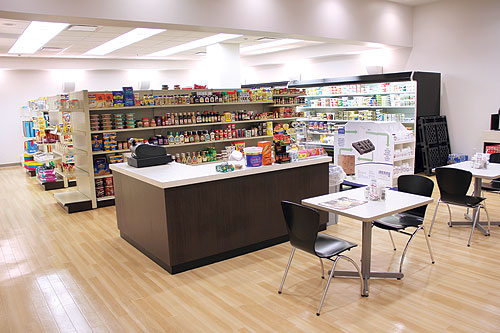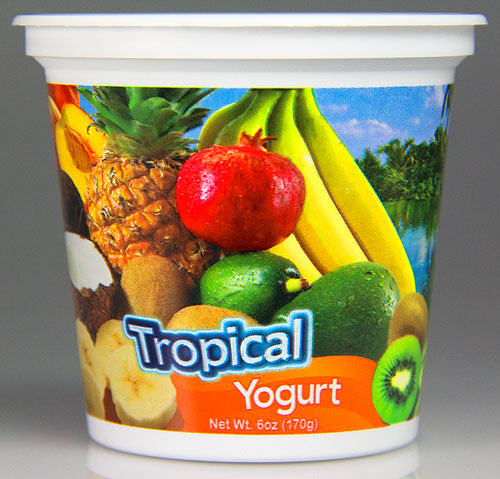Creative Services Set Berry Plastics Apart
by Dianna Brodine

A small percentage of the Berry Plastics' heat transfer labeling is outsourced, but the majority of all decorating services are completed in-house.

The Creative Services department also ensures that the correct printing process is used to produce the correct decorative effect, like making items pop off the retail shelf, at the lowest cost to the customer.

Over the last five years, Berry Plastics' customers continued to upgrade their graphics, keeping the Creative Services team busy as it worked to enhance artwork.

Indirect flexographic printing is a patent-pending process that allows Berry Plastics to produce excellent photographic quality graphics on white, clear and colored substrates.

Berry Plastics purchased its first indirect flexo machine three years ago from its partner, OMSO S.p.A.
Berry Plastics began as a small injection molder headquartered in Evansville, IN, but today the company has more than 15,000 employees in manufacturing facilities across the globe. Its growth as a leading producer of plastic packaging is impressive in its own right, but the company's Creative Services department is part of what makes its customers' containers stand out on retail shelves.
From one facility to 80
In 1967, Imperial Plastics was established in Evansville, IN. The injection molding company entered the container packaging market in 1972; and in 1983, it caught the attention of Jack Berry Sr., an orange grower looking to diversify. He purchased the company and renamed it Berry Plastics, kicking off three decades of aggressive growth.
In 1987, a second manufacturing facility was opened in Henderson, NV, and then a series of acquisitions began in 1988 with Gilbert Plastics, a New Jersey manufacturer of aerosol overcaps. The drink cup, consumer products and closures markets were next, with successful entries into those areas in 1995, 1997 and 1998, respectively. Berry Plastics was purchased by Apollo Management L.P. and Graham Partners, Inc. in 2006, and the company then merged with Covalence Specialty Materials in 2007.
Other notable growth included bottles, tubes and prescription vials with the acquisition of Kerr in 2005 and an expansion of Berry's food, grocery, medical and personal packaging and films offering in 2009. In 2012, Berry Plastics Group, Inc. – now with more than 80 facilities worldwide – began trading shares on the New York Stock Exchange.
Today, Berry Plastics is comprised of four divisions: Engineered Materials, Flexible Packaging, Rigid Closed Top and Rigid Open Top. The company has grown into a leading global manufacturer of injection-molded plastic packaging, thermoformed and blow molded products, flexible films and packaging, as well as tapes and corrosion protection products.
While the company's offerings are impressive, it is on the design side that Berry Plastics distinguishes itself. "Berry Plastics prides itself in the complete service offering, from initial design to delivery," explained Eva Schmitz, communications manager for Berry Plastics. "Decorating is one such service, allowing us to work with our customer to design a package that stands out on the store shelf."
A comprehensive list of decorating services are offered on the company website, including flexographic print, indirect flexographic print, screen print, offset print, heat transfer labels, pressure-sensitive labels, in-mold labels, shrink sleeves, hot stamping and metalizing. A small percentage of the company's heat transfer labeling is outsourced, but the majority of all decorating services are completed in-house. Customers in most of Berry Plastics' markets utilize its decorating expertise, including food and beverage packaging, personal care, household and automotive. Consumer-oriented markets comprise nearly 75 percent of the molder's decorating service industries.
Creative Services department stands apart
Design services on such a large scale require significant human resources. More than 50 individuals work within the Creative Services department at Berry Plastics, from coordinating staff to artists to prepress employees. While the majority of the artwork for the rigid containers is sent in from outside designers, the Creative Services staff must work with each container design to ensure the separations are correct and that the printing department has a thorough understanding of the design elements. This ensures that the final container artwork echoes the customers' intentions.
The Creative Services department also ensures that the correct printing process is used to produce the correct decorative effect at the lowest cost to the customer. "I started in 1989, and we were printing dry offset only at that time," said Jennye Scott, vice president of creative services at Berry Plastics. "Dry offset still is a significant portion of our decorating services, but the type of decorative printing we recommend will depend on the part size." For instance, dry offset printing is the least expensive option for decorating plastic containers and cups; whereas, laminate tubes often are screen printed to add a tactile feel or to print a white background that later will be overprinted with another decorating technique. Hot stamping, which was added about five years ago, is popular for personal care items that need to pop off the retail shelf, and cold foil was added within the last two years as another option.
"We understand the customers' needs, which helps us explain to them which technology is best," Scott said. "Our diversification of decorating services helps us stand apart because we can match the services that we offer to work with the customers within their budgetary restrictions."
Adding indirect flexo capabilities
While the economic climate over the past five years has been challenging for many molders, Scott explained that Berry Plastics' customers continued to upgrade their graphics, keeping the Creative Services team busy as it worked to enhance artwork. "Our customers were able to take advantage of our new technologies to create custom graphics that make their product stand out on the store shelf," she explained.
One of the new technologies referenced is indirect flexographic printing. "Indirect flexo is a new hybrid process that Berry Plastics has exclusive rights to in North America," said Scott. "Our ServoCup equipment can flexo print directly onto containers or drink cups, and we have five of these machines in different locations."
According to a press release from the company, indirect flexographic printing was developed as an alternative to dry offset printing. It is a patent-pending process that allows Berry Plastics to produce excellent photographic quality graphics on white, clear and colored substrates through utilization of high-resolution digital plate imaging and true CMYK flexographic process. This allows for softer edges, better highlights and the ability to replicate the full-color spectrum. In addition, the indirect flexo process allows for this high-end printing to occur directly on the injection or thermoform part by compensating for the angle between the top and the bottom of the cup or container.
Berry Plastics purchased its first indirect flexo machine three years ago from its partner, OMSO S.p.A. "We were very excited about this technology, since it allowed us to get true 4-color flexographic printing onto 3D containers and drink cups, whereas traditional flexographic printing usually is only printed on flat substrates," said Scott. "Once we saw the possibilities, we pursued it, and this spring we received the 2013 Technical Innovation Award from the Flexographic Technical Association (FTA) because of our indirect flexographic printing capabilities."
Teaching decorating techniques
The acquisition of 12 different printing companies meant that 12 different training programs were in place for print technicians and creative staff. Berry Plastics has taken the best from all of these and incorporated them into a program called Berry University.
"Berry University is an application that is housed on our intranet," Schmitz explained. "Employees across all Berry locations can log in and take courses, whether those courses are safety-related or training skill sets." Employees can use computers set up in common areas to work their way through a presentation, and a test related to the content follows.
In Creative Services, Berry University functions as a training tool to ensure all 50 staff members are fully immersed in the company's decorating options. "We set up learning maps for our employees," Scott said. "With 10 decorating options available, Creative Services employees learn about each decorating technology in order to advance in our group. Learning maps help them follow a required course set to achieve each level." In addition, other employees, including those on the production floor, can take the classes to advance their own understanding of the decorating processes, or Creative Services staff can take courses on the various molding processes.
In conjunction with Berry University, the company also works very closely with the FTA to train employees on flexographic printing techniques. More than 190 employees have gone through or are going through the FTA's FIRST (Flexographic Image Reproduction Specifications & Tolerances) program, and the Evansville location is FIRST certified.
The FTA's FIRST Operator Certification Program is designed to help process technicians measure and control the flexographic printing process. The online testing program offers three levels of certification, from press to prepress to implementation. According to the FTA, the purpose of the FIRST Company Certification Program is to recognize flexographic printing companies that are applying FIRST methodology and have attained compliance with the specifications and tolerances related to communication and implementation, design, prepress and press as detailed in the most current FIRST document.
"Along with trying to follow the FIRST standards, we're also working on training with our print techs to try to standardize our internal processes," said Scott. "Each location has different equipment and different ways they've been trained, so we're trying to get everyone on the same page." Berry Plastics also is on the verge of introducing a color program for dry offset printing.
"Basically, we are using the FIRST standards as a guideline for our dry offset print technology," she explained. "Most of the approvals for dry offset are visual, which results in the technician on the floor approving the target sample. Now we're introducing a color program, so they are able to measure the colors to ensure consistency whether first shift or night shift, which removes subjectivity from the visual approval."
Scott pointed out that the processes for dry offset and flexographic printing are very different, which makes it more difficult to train employees in the processes. "By introducing these standards, we can take dry offset to the next level and ensure consistency and excellence across all facilities," said Scott.
Working together to exceed expectations
Achieving decorating excellence across such a large and geographically scattered company requires that the Creative Services department works closely with the press floor. "We have a lot of tools that help us communicate with our printing departments," Scott explained. "We will send out a PDF to ask for their thoughts and concerns when creating new artwork, and we can do quick design reviews to make sure they're ok with the separations we're planning. They know their equipment better than we do, so it's important to get their feedback."
To ensure the artists have a solid understanding of the equipment capabilities, they spend time in the sample room, on the printing floor and with all areas inside the Creative Services department, including scheduling and preflight. Feedback after a job has been produced also is critical to future success. "The plants are always sending samples to the artists so they can see how the job ran," said Scott. "We gather a lot of information to understand what the equipment is capable of and what it's not."
"Even though Berry is a large company, one of the characteristics that sets it apart is its culture," explained Schmitz. "Berry has been able to maintain a culture that's really dedicated to its employees internally, while externally making sure we are meeting customer needs and developing new processes to exceed them."
"It's all about using teamwork to exceed customer's expectations," Scott said .

